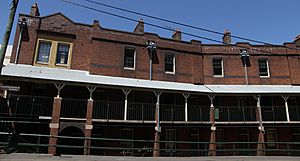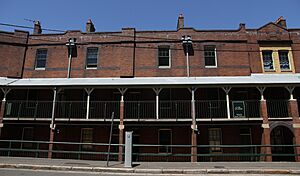46-56 Gloucester Street, The Rocks facts for kids
Quick facts for kids 46-56 Gloucester Street, The Rocks |
|
|---|---|

46-54 Gloucester Street, pictured in 2019
|
|
| Location | 46-56 Gloucester Street, The Rocks, City of Sydney, New South Wales, Australia |
| Built | 1914 |
| Owner | Privately owned and Property NSW |
| Official name: Terraces; Edwardian Cottages | |
| Type | State heritage (built) |
| Designated | 10 May 2002 |
| Reference no. | 1609 |
| Type | Terrace |
| Category | Residential buildings (private) |
| Lua error in Module:Location_map at line 420: attempt to index field 'wikibase' (a nil value). | |
The buildings at 46-56 Gloucester Street, The Rocks are a group of historic homes in The Rocks, a famous area in Sydney, Australia. These homes were built in 1914. They are also known as the Edwardian Cottages.
Some of the property is privately owned. The rest belongs to Property NSW, which is a government agency. These buildings are very important to the history of New South Wales. They were added to the New South Wales State Heritage Register on 10 May 2002. This means they are protected because of their special historical value.
Contents
History of the Gloucester Street Homes
The land where these homes now stand has a long history. In the 1830s, different parts of this land were claimed by several people. For example, William Long, Jane Farrell, and Mary Lupton were some of the early owners.
Later, in the 1860s and 1870s, two Customs House Agents, William and John Smith, bought up much of this land. Maps from the 1860s show that some buildings were already there. These older buildings mostly faced Cambridge Street, which was closer to the harbour.
By the late 1800s, the land was still being bought and sold. Most of the buyers worked in the area. In 1901, the government took control of the entire site. This was part of a big project to clean up and rebuild parts of The Rocks. Many old buildings were taken down, especially those built before 1838.
Building New Homes
After the old buildings were removed, plans were made for new homes. The current buildings were constructed between 1902 and 1911. They were first listed in the Sands Directory (a type of old phone book) in 1912, with 16 families living there.
These new homes were built in the Federation style. This style often used exposed brickwork. The government wanted these homes to be strong and easy to maintain. They used new building methods, like double-skin brickwork, which made the walls more durable. They also used strong materials like steel and concrete for stairs and landings instead of just wood.
Who Managed the Homes?
A group called the Housing Board managed the buildings from 1912 until 1924. After that, the Sydney Harbour Trust took over. In the 1930s, the Maritime Service Board managed the area.
In 1970, the Sydney Cove Redevelopment Authority (SCRA) became the landlords. Their goal was to provide affordable housing in The Rocks. In the 1980s, there were plans to upgrade the buildings. The SCRA wanted to keep the homes in good condition and meet modern housing standards.
In 1988, the SCRA officially leased all the units to the New South Wales Land and Housing Corporation. This lease was for 99 years, ending in 2087. This shows a long-term commitment to providing public housing in this historic area.
What the Homes Look Like
The buildings at 46-56 Gloucester Street are called "The Edwardian Cottages." They are a group of 16 units, arranged in eight terraces. Each unit has three bedrooms and is spread over two floors, like a duplex.
The buildings are built on a slope, so they are on four different levels. The main side faces Gloucester Street, and there's another side facing Cambridge Street. The buildings gently curve along with the street.
- Style: Edwardian terrace
- Storeys: 4 (because of the slope)
- Outside: Brick
- Floors: Timber
- Ceilings: Metal
Condition of the Buildings
As of 2001, the buildings were in good condition after being restored. The land underneath has been disturbed a lot over time. This is because of all the building and changes made to the hill.
Why These Homes Are Important
The homes at 46-56 Gloucester Street are very important to the history and culture of New South Wales. They are part of the larger Rocks area, which is also a significant heritage site.
Historical Importance
These terraces are important because they show the big public works projects that happened after old buildings were cleared from The Rocks. They are good examples of early public housing built in the early 1900s. They show that the government cared about good building and health standards for people living in The Rocks.
The construction of these homes also shows a social concern for people who lost their homes during the clean-up. They have always been used for public housing since they were built.
Association with Government Groups
These homes have been managed by many government groups over the years. These include the Housing Board, Sydney Harbour Trust, and the Department of Housing. The Government Architect's Branch, led by Walter Liberty Vernon, designed some of these "model" workers' homes.
Design and Beauty
The terraces are also important for their design. They are a good example of Federation-style homes. They were built in a clever way to fit the sloping land. They have two-storey units that step down the hill. This design allowed for many homes to be built in a small area.
The buildings use typical Federation details like brick walls and timber. But they also show new ideas in building materials, like steel and concrete. This made them more durable and easier to maintain. They stand out on Gloucester Street with their brick facades and two-storey verandahs.
Community Connection
These homes have a strong connection to the local community. They have provided public housing in The Rocks for a very long time, since 1912. Many families have lived here over the decades.
What We Can Learn From Them
The buildings can teach us about building techniques and living standards in the early 1900s. They show how homes changed to include things like kitchens and indoor bathrooms.
Even though the area has been changed a lot, there might still be old wells or other features hidden underground.
Rarity
These terraces are a rare example of public housing from the early 20th century in The Rocks. Most other public housing from that time was single-storey. These two-storey units are quite unique.
Representative Example
Overall, these buildings are a great example of public housing from the early 1900s. They show how housing design changed to improve living conditions after the big clean-up projects in The Rocks.


